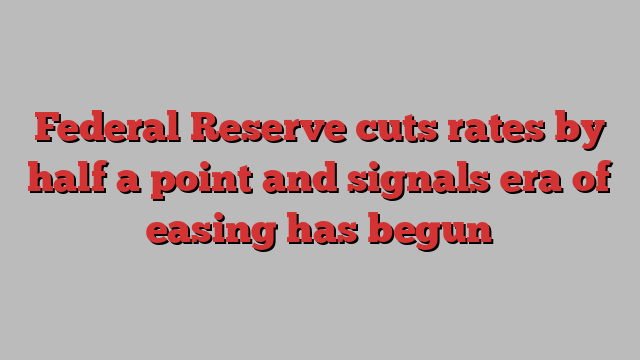
Unlock the Editor’s Digest for free
Roula Khalaf, Editor of the FT, selects her favourite stories in this weekly newsletter.
The Federal Reserve cut its benchmark interest rate by half a percentage point on Wednesday and signalled more reductions would follow, launching its first easing cycle since the onset of the pandemic.
The US central bank’s first cut in more than four years leaves the federal funds rate at a range of 4.75 per cent to 5 per cent. Michelle Bowman, a governor on the Federal Open Market Committee, voted against the decision, favouring a quarter-point reduction.
The half-point cut is larger than the Fed’s more customary quarter-point pace and suggests the US central bank is concerned about the prospects of a weakening economy after more than a year of holding rates at a 23-year high.
The last time the Fed cut rates by more than a quarter point was when Covid-19 tore across the global economy in 2020.
In a policy statement on Wednesday, the FOMC said it had gained “greater confidence” about inflation, even though it remained “somewhat elevated”.
Amid slowing job gains and a higher unemployment rate, officials noted the risks to achieving their price stability goal while also maintaining a healthy labour market were “roughly in balance”.
In the latest “dot plot” of officials’ forecasts, most expected the policy rate would fall to 4.25 per cent to 4.5 per cent by the end of 2024, suggesting another large half-point reduction at either of the two remaining meetings this year or two quarter-point reductions. Overall, that is a significantly larger reduction than the quarter-point reduction projected by most officials in June, when the dot plot was last updated.
Policymakers also expected the funds rate to fall another percentage point in 2025, ending the year between 3.25-3.5 per cent. By the end of 2026, it was estimated to fall just below 3 per cent.
In considering additional cuts, the FOMC said it would “carefully assess incoming data, the evolving outlook, and the balance of risks”.
Wednesday’s decision is a milestone for the central bank after more than two years battling inflation — and a significant moment in this year’s presidential election.
Falling borrowing costs will be a boon for Democratic candidate Kamala Harris, whose campaign has been dogged by voter disquiet over high living costs even as the US economy has boomed.
The cut comes as Fed officials grow more confident that inflation is under control and turn their focus to the health of the labour market.
After peaking in 2022 at about 7 per cent, the personal consumption expenditures price index was just 2.5 per cent in July, closer to the Fed’s 2 per cent target.
But jobs growth has cooled in recent months and other measures of demand, such as vacancies, have also slowed, even though the number of Americans filing for unemployment benefits remains historically low.
While the Fed has made clear it does not want to see further labour market weakening it is also concerned about moving too slowly in loosening its grip on the economy by lowering borrowing costs.